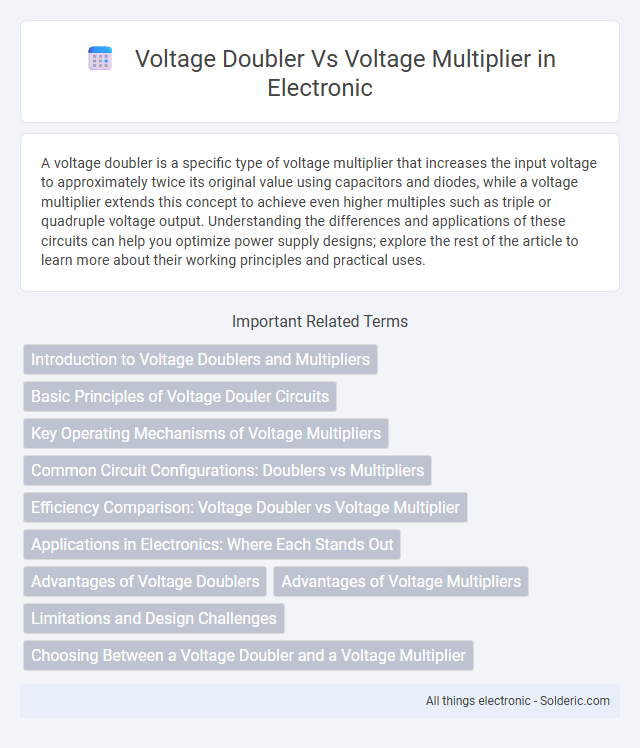A voltage doubler is a specific type of voltage multiplier that increases the input voltage to approximately twice its original value using capacitors and diodes, while a voltage multiplier extends this concept to achieve even higher multiples such as triple or quadruple voltage output. Understanding the differences and applications of these circuits can help you optimize power supply designs; explore the rest of the article to learn more about their working principles and practical uses.
Comparison Table
| Feature | Voltage Doubler | Voltage Multiplier |
|---|---|---|
| Definition | Circuit that doubles input AC voltage. | Circuit that multiplies input voltage by a factor greater than two. |
| Output Voltage | Approximately 2 x input voltage peak. | Multiple times input voltage peak, depending on stages. |
| Complexity | Simple; uses 2 diodes and 2 capacitors. | More complex; multiple diode-capacitor stages. |
| Applications | Low-power voltage doubling in power supplies. | High voltage generation in CRTs, ionizers, photocopiers. |
| Ripple Voltage | Higher ripple compared to multipliers with filtering. | Lower ripple with more stages and filtering. |
| Voltage Regulation | Limited; output drops with load. | Better with increased stages and components. |
| Efficiency | Moderate efficiency at doubling voltage. | Lower efficiency in higher multiplication stages. |
Introduction to Voltage Doublers and Multipliers
Voltage doublers are specific types of voltage multipliers designed to increase an input voltage to approximately twice its original amplitude using diode-capacitor circuits. Voltage multipliers extend this principle to generate higher voltages, often by cascading voltage doubler stages, enabling outputs that are multiples of the input voltage. Both circuits are essential in power supply design where high voltage from a low-voltage source is required without using inductive transformers.
Basic Principles of Voltage Douler Circuits
Voltage doubler circuits operate by effectively doubling an input AC voltage to produce a DC output approximately twice the peak input voltage using capacitors and diodes. This is achieved through sequential charging and discharging cycles, where capacitors store charge during one half-cycle and transfer it during the other, increasing the voltage level. Your application benefits from this by providing a simple, efficient means to generate higher DC voltages from a lower AC source without requiring a transformer.
Key Operating Mechanisms of Voltage Multipliers
Voltage multipliers use capacitors and diodes arranged in specific configurations to convert AC input voltage into a higher DC output voltage by sequentially charging capacitors and stacking their voltages. In a voltage doubler, a simple voltage multiplier variant, two capacitors and diodes work together to produce an output nearly twice the input peak voltage. Understanding these operating mechanisms helps you select the optimal voltage multiplier for applications needing efficient voltage step-up without transformers.
Common Circuit Configurations: Doublers vs Multipliers
Voltage doublers commonly use configurations like the Cockcroft-Walton or Villard circuits to efficiently double an input AC voltage into a higher DC output. Voltage multipliers extend this concept by cascading multiple stages of diodes and capacitors, enabling output voltages several times higher than the input. Your choice between doublers and multipliers depends on the required voltage amplification and circuit complexity.
Efficiency Comparison: Voltage Doubler vs Voltage Multiplier
Voltage doubler circuits typically offer higher efficiency at lower voltage multiplication factors due to fewer diode drops and reduced component losses. Voltage multipliers, while capable of achieving higher output voltages by cascading stages, tend to suffer from increased ripple voltage and reduced efficiency as the number of stages increases. Your choice between a voltage doubler and a multiplier depends on the required voltage level and efficiency constraints in your application.
Applications in Electronics: Where Each Stands Out
Voltage doublers are commonly used in low-power electronic circuits requiring a simple increase in DC voltage, such as powering small sensors or LCD displays. Voltage multipliers serve high-voltage applications like CRTs, photomultiplier tubes, and high-voltage power supplies by stacking multiple stages to generate significantly higher voltages from a low-voltage AC source. Your choice depends on the voltage increase needed and the complexity you can accommodate in your circuit design.
Advantages of Voltage Doublers
Voltage doublers offer increased output voltage using fewer components compared to complex voltage multipliers, resulting in reduced circuit size and cost. They provide higher efficiency in low-power applications by minimizing power loss and simplifying the design. Voltage doublers are ideal for powering devices requiring moderate voltage increase without the complexity of cascaded voltage stages found in multipliers.
Advantages of Voltage Multipliers
Voltage multipliers offer the advantage of generating high DC voltages from a low AC input without the need for bulky transformers, making them ideal for compact electronic designs. They efficiently increase voltage levels by cascading multiple stages, enabling applications in CRTs, photomultiplier tubes, and X-ray machines. Your circuits benefit from reduced complexity and cost while achieving substantially higher output voltages than simple voltage doublers.
Limitations and Design Challenges
Voltage doublers and voltage multipliers face limitations such as increased ripple voltage and reduced efficiency due to diode voltage drops and capacitor leakage, impacting overall performance. Designing these circuits requires careful consideration of component tolerances, switching frequencies, and load conditions to maintain voltage stability and minimize losses. You must address challenges like voltage stress on components and thermal management to ensure reliable operation in high-voltage applications.
Choosing Between a Voltage Doubler and a Voltage Multiplier
Choosing between a voltage doubler and a voltage multiplier depends on the required output voltage and circuit complexity. Voltage doublers provide a simple, cost-effective solution for obtaining approximately twice the input voltage, ideal for low to moderate voltage increases. Voltage multipliers, such as Cockcroft-Walton circuits, offer higher voltage gains by cascading stages but involve increased component count and higher losses, making them suitable for applications demanding significantly elevated voltages.
voltage doubler vs voltage multiplier Infographic

 solderic.com
solderic.com